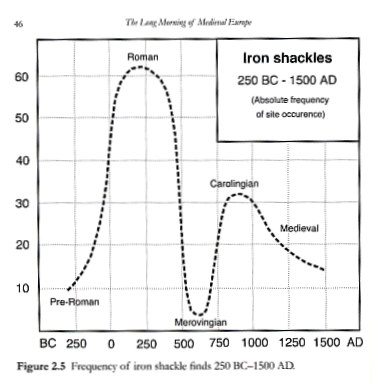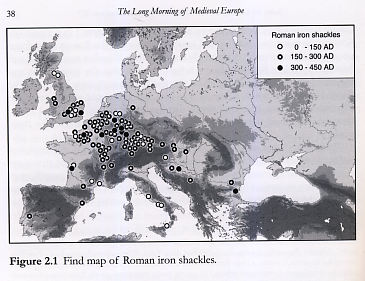Wednesday, March 03, 2010
An interesting round-up of Scottish and Pictish-themed movies at Codex Celtica, as well as discussion of new pop-historical writing on King Arthur.
Tuesday, February 23, 2010
Slavery, Vikings, and Charlemagne
Here is a little bit of synchronicity in my historical reading. I am not sure if it "proves" anything, other than the fact that it is difficult to sort people into "good guys" and "bad guys."
1. At the library, I recently picked up The Long Morning of Medieval Europe: New Directions in Early Medieval Studies , ed. Jennifer R. Davis and Michael McCormick.
, ed. Jennifer R. Davis and Michael McCormick.
I wanted to look for some material on agriculture—the adoption of the three-field system, wheeled plows, etc.—but I was sucked into a chapter entitled, "Strong Rulers—Weak Economy? Rome, the Carolingians and the Archaeology of Slavery in the First Millennium AD" by a German scholar, Joachim Henning.
Here are two figures that I have lifted from his work:
As I used to tell my students when we talked about American religion and slavery, the Roman empire back in Jesus' time ran on slavery the way that our civilization runs on petroleum. (And Jesus had nothing to say about it.)
Slavery requires chains and shackles, lest the slaves wander away. Figure 2.1 is a map of archaeological sites (farms, villas, plantations) containing shackles.

The second figure graphs shackle finds over time in Gaul (France, roughly). They rise during the Roman times, then plunge during the Merovingian dynasty, during the so-called Dark Ages.
But then shackle finds—and hence presumably slavery—rise during the Carologian dynasty. Its founder, Charles Martel (ca. 688-741), stopped the Islamic expansion into Europe. His grandson Charlemagne (Charles the Great) is a huge figure in medieval western European history, but his actions included the slaughter of more than 4,000 Saxons who resisted conversion to Christianity.
There was a European slave trade in Pagan, polytheistic Roman times—and it continued into Christian times, up through the 1400s, at least—and then it was time for Columbus!
2. Meanwhile, a British historian suggests that Viking raids on Europe might have been payback for Charlemagne's forced-conversion program. (Via the Covenant of the Goddess NPIO blog.)
But before you annoint the Vikings as the pro-Pagan "good guys," remember that they were in the slave trade too, particularly in what is now Ireland and Russia.
As some people say about their relationships on Facebook, "It's complicated."
1. At the library, I recently picked up The Long Morning of Medieval Europe: New Directions in Early Medieval Studies
I wanted to look for some material on agriculture—the adoption of the three-field system, wheeled plows, etc.—but I was sucked into a chapter entitled, "Strong Rulers—Weak Economy? Rome, the Carolingians and the Archaeology of Slavery in the First Millennium AD" by a German scholar, Joachim Henning.
Here are two figures that I have lifted from his work:
As I used to tell my students when we talked about American religion and slavery, the Roman empire back in Jesus' time ran on slavery the way that our civilization runs on petroleum. (And Jesus had nothing to say about it.)
Slavery requires chains and shackles, lest the slaves wander away. Figure 2.1 is a map of archaeological sites (farms, villas, plantations) containing shackles.

The second figure graphs shackle finds over time in Gaul (France, roughly). They rise during the Roman times, then plunge during the Merovingian dynasty, during the so-called Dark Ages.
But then shackle finds—and hence presumably slavery—rise during the Carologian dynasty. Its founder, Charles Martel (ca. 688-741), stopped the Islamic expansion into Europe. His grandson Charlemagne (Charles the Great) is a huge figure in medieval western European history, but his actions included the slaughter of more than 4,000 Saxons who resisted conversion to Christianity.
There was a European slave trade in Pagan, polytheistic Roman times—and it continued into Christian times, up through the 1400s, at least—and then it was time for Columbus!
2. Meanwhile, a British historian suggests that Viking raids on Europe might have been payback for Charlemagne's forced-conversion program. (Via the Covenant of the Goddess NPIO blog.)
But before you annoint the Vikings as the pro-Pagan "good guys," remember that they were in the slave trade too, particularly in what is now Ireland and Russia.
As some people say about their relationships on Facebook, "It's complicated."
Saturday, January 09, 2010
It's Cool to be Medieval
At least according to critic Philip Hensher, writing in a British newspaper, who says that medieval is the new black:
It’s never easy to account for fashion, but perhaps some real factors have contributed to the reading matter of 2010. This last year has seen a world-wide fear of a destructive plague, in the shape of swine flu. The court of our leader has grown increasingly suspicious, withdrawn and riddled with the sort of plots usually termed Byzantine. The coffers are empty, and an expensive foreign war against parts of the Muslim world has to be paid for somehow. It all sounds a little bit medieval, and that is what we’ve been reading about.
Other disasters have been weighing heavily on our minds, and refer back directly to the Middle Ages. In the climate change debate, both sceptics and proponents have spent a lot of time debating the significance for our own times of two parts of the period. The first is what has been termed the Medieval Warm Period, from between 800 to 1300, the second the Little Ice Age that followed it. Those in the Christopher Booker and George Monbiot camp, one which blames humans for climate change, have spent a lot of heated discussion dwelling on these facts, and the debate has found its way into creative works in surprising ways. We think about future catastrophe as a consequence of our past sins in very medieval ways.
There is more, largely about novels.
It’s never easy to account for fashion, but perhaps some real factors have contributed to the reading matter of 2010. This last year has seen a world-wide fear of a destructive plague, in the shape of swine flu. The court of our leader has grown increasingly suspicious, withdrawn and riddled with the sort of plots usually termed Byzantine. The coffers are empty, and an expensive foreign war against parts of the Muslim world has to be paid for somehow. It all sounds a little bit medieval, and that is what we’ve been reading about.
Other disasters have been weighing heavily on our minds, and refer back directly to the Middle Ages. In the climate change debate, both sceptics and proponents have spent a lot of time debating the significance for our own times of two parts of the period. The first is what has been termed the Medieval Warm Period, from between 800 to 1300, the second the Little Ice Age that followed it. Those in the Christopher Booker and George Monbiot camp, one which blames humans for climate change, have spent a lot of heated discussion dwelling on these facts, and the debate has found its way into creative works in surprising ways. We think about future catastrophe as a consequence of our past sins in very medieval ways.
There is more, largely about novels.
Tuesday, December 22, 2009
One Night during the Cold War
I was walking around today in Manitou Springs, once a spa-resort town, located in the foothills west of Colorado Springs.
You should know that there are no springs in Colorado Springs--real-estate developers lied in the 1870s too. The springs are in Manitou.
But Colorado Springs has several important military installations: Fort Carson, NORAD, and so on.
Manitou is in a tight valley, and Ruxton Avenue, one of the main streets, goes up a side canyon, where the sun rarely clears the snow and ice, so you step carefully past the little storefronts where various hopeful artsy types open galleries and craft shops and then are gone six months later.
I looked down at one of the Victorian houses across the creek, and a memory of the Cold War years came back.
It was winter then too. M. and I, not long married, lived elsewhere in Manitou.
One night in the early 1980s, I was visiting friends who rented that particular house then, and I came out around 10 p.m to see a narrow view of the sky to the north.
The sky was glowing blood red.
Faster than you can read these words, I thought, "That's it. Soviet missiles have hit Denver. We're next. We'll all be dead before I can get home to say goodbye to her."
Then my rational mind belatedly suggested, "Maybe it's the Northern Lights."
At 38 degrees-something north, we do not see the aurora borealis often—in fact, almost never.
Had it not been for the planetarium shows I had watched as a kid at the natural history museum in Denver, I might not have known what I was seeing.
I went home then to find M. also a little shaken by the sight. After we reassured ourselves that we were still alive, we watched the aurora until it faded. It was front-page news in the next day's local papers.
It all came back to me as I walked back down to the main thoroughfare to look for her Christmas present. We're still alive.
You should know that there are no springs in Colorado Springs--real-estate developers lied in the 1870s too. The springs are in Manitou.
But Colorado Springs has several important military installations: Fort Carson, NORAD, and so on.
Manitou is in a tight valley, and Ruxton Avenue, one of the main streets, goes up a side canyon, where the sun rarely clears the snow and ice, so you step carefully past the little storefronts where various hopeful artsy types open galleries and craft shops and then are gone six months later.
I looked down at one of the Victorian houses across the creek, and a memory of the Cold War years came back.
It was winter then too. M. and I, not long married, lived elsewhere in Manitou.
One night in the early 1980s, I was visiting friends who rented that particular house then, and I came out around 10 p.m to see a narrow view of the sky to the north.
The sky was glowing blood red.
Faster than you can read these words, I thought, "That's it. Soviet missiles have hit Denver. We're next. We'll all be dead before I can get home to say goodbye to her."
Then my rational mind belatedly suggested, "Maybe it's the Northern Lights."
At 38 degrees-something north, we do not see the aurora borealis often—in fact, almost never.
Had it not been for the planetarium shows I had watched as a kid at the natural history museum in Denver, I might not have known what I was seeing.
I went home then to find M. also a little shaken by the sight. After we reassured ourselves that we were still alive, we watched the aurora until it faded. It was front-page news in the next day's local papers.
It all came back to me as I walked back down to the main thoroughfare to look for her Christmas present. We're still alive.




